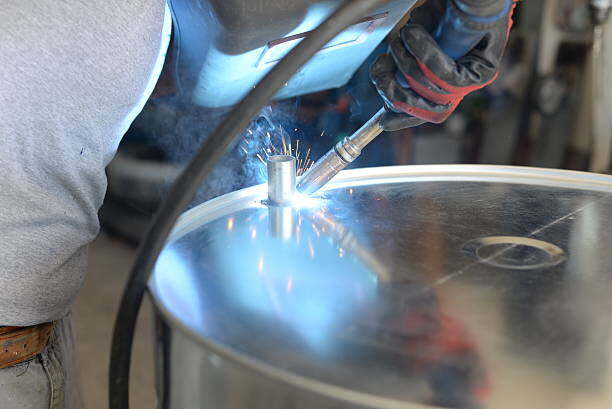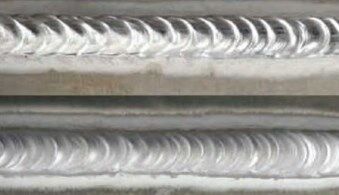MIG welding, or Gas Metal Arc Welding (GMAW), is one of the most versatile and widely used welding processes in the industry. Known for its speed, efficiency, and ease of use, MIG welding is ideal for joining a variety of metals, including steel, stainless steel, aluminum, and more. However, like any welding process, achieving consistent, high-quality results requires a combination of skill, practice, and attention to detail. In this article, we’ll share expert MIG welding tips and techniques to help you take your welding to the next level.

I. MIG Welding Basics
Before diving into advanced techniques, it’s essential to understand the fundamentals of MIG welding. Here’s a quick overview:
MIG welding uses a continuous wire electrode fed through a welding gun, combined with a shielding gas to protect the weld pool from atmospheric contamination. The process is suitable for welding thin and thick materials in various positions, including flat, horizontal, vertical, and overhead. Its versatility makes it a favorite among professionals and hobbyists alike.
However, MIG welding isn’t without challenges. Issues like spatter, porosity, lack of fusion, and distortion can arise if proper techniques and settings aren’t used. The good news is that these challenges can be easily overcome with the right approach.
II. Essential MIG Welding Tips and Techniques
To achieve professional-grade welds, follow these expert tips:
1. Choose the Right Shielding Gas and Wire
The shielding gas and wire combination plays a critical role in the quality of your welds. Different metals require different gases and wire diameters:

For Steel: A mix of 75% Argon and 25% CO2 is ideal for most steel applications. This gas combination provides excellent penetration and minimizes spatter.
For Stainless Steel: Use 100% Argon to avoid contamination and ensure a clean, corrosion-resistant weld.
For Aluminum: A 100% Argon gas with a specialized aluminum MIG wire is recommended. This setup ensures proper fusion and avoids porosity.
When selecting wire diameter, thinner wires are better for thin materials, while thicker wires are suitable for heavier gauge metals. Always consult the manufacturer’s recommendations for the best results. For more, please the article: Which Shielding Gas Should You Use for MIG/MAG Welding?
2. Prepare Your Metal Surface
Cleanliness is key to a successful weld. Contaminants like grease, oil, rust, and paint can cause porosity, lack of fusion, and other defects. Use the following steps to prepare your metal:
Clean the Surface: Use a wire brush or sandpaper to remove rust, dirt, and other contaminants.
Remove Oil or Grease: Wipe the surface with a solvent to eliminate any residue.
Ensure Proper Fit-Up: Gaps between the pieces can lead to incomplete fusion. Use clamps or fixtures to hold the workpieces firmly together.
3. Set Up Your Welding Machine Correctly
Your welding machine settings will make or break the quality of your weld. Here’s how to get it right:
Voltage and Wire Feed Speed: Adjust these parameters based on the thickness of your metal and the type of wire you’re using. A higher wire feed speed increases the current, which is necessary for thicker materials.
Arc Length (Stickout): Maintain a consistent arc length of 1/4 to 3/8 inch for solid wires. Flux-cored wires may require a slightly longer arc length.
Polarity: For most MIG welding applications, use DCEP (Direct Current Electrode Positive) polarity. This setting provides the best arc stability and penetration.
For more tips about industrial mig welding setting, read the article: Industrial MIG Welding: Setting the Correct Parameters
4. Maintain Proper Torch Angle and Travel Speed
The torch angle and travel speed are critical for achieving a smooth, consistent weld bead:
Torch Angle: Use a slight pushing technique (10-15 degrees) for most applications. This angle provides better gas coverage and minimizes spatter.
Travel Speed: Maintain a steady travel speed that matches your wire feed rate. Too slow, and you’ll create a wide, convex bead; too fast, and the bead will be narrow and lack penetration.
For more tips about mig welding thin materials, please read Tips for Setting MIG Welding Parameters for Thin Materials
5. Monitor and Adjust Your Weld Bead
One of the best ways to improve your welding skills is to read your weld bead and make adjustments as needed:
Undercutting: If the weld bead has an undercut, reduce your travel speed or lower your voltage.
Porosity: Check for proper gas flow and ensure the metal surface is clean. Porosity is often caused by contaminants or insufficient shielding gas.
Spatter: Reduce spatter by adjusting your arc length, voltage, or gas flow. A shorter arc and higher voltage can help minimize spatter.
III. Advanced MIG Welding Techniques
Taking your welding to the next level involves mastering advanced techniques:
1. Pulse MIG Welding
Pulsed MIG welding uses a pulsing current to create a controlled weld pool. This technique is ideal for thin materials, as it reduces heat input and prevents burn-through. To implement pulse welding:

2. Welding in Different Positions
Welding in vertical, horizontal, or overhead positions requires adjustments to your technique:
Vertical Welding: Use a slight pushing angle and slower travel speed to control the weld pool.
Horizontal Welding: Maintain a steady, straight motion to ensure even penetration.
Overhead Welding: Use a shorter arc length and faster travel speed to prevent the weld pool from sagging.
3. Using the Weaving Technique
The weaving technique involves moving the torch in a side-to-side motion to achieve wider weld beads and better fusion. This method is particularly useful for thick materials and joint designs that require full penetration.
Zig-Zag Weave: Ideal for wider joints and thicker materials.
Circular Weave: Provides a smooth, uniform weld bead for flat surfaces.
IV. Common MIG Welding Mistakes and How to Avoid Them
Even experienced welders can encounter issues if they’re not careful. Here’s how to avoid common MIG welding mistakes:
1. Inconsistent Arc Length
2. Poor Penetration
3. Excessive Spatter
4. Lack of Fusion
V. FAQs on MIG Welding
Q1: What is the best shielding gas for MIG welding steel?
Q2: Can MIG welding be used for aluminum?
Q3: How do I prevent burn-through when welding thin materials?
Q4: What causes porosity in MIG welds?
Q5: Can MIG welding be used for overhead welding?
Conclusion
MIG welding is a powerful and versatile process that can deliver exceptional results when executed properly. By following these expert tips and techniques, you can overcome common challenges and achieve high-quality welds. Whether you’re working on a small project or a large-scale industrial application, mastering MIG welding will open up a world of possibilities.
Related article
1. 11 Tips to Sharpen Your MIG Welding Skills
2. Spot Welding vs. TIG Welding vs. MIG Welding: Differences & How to Choose?
3. Pulsed MIG Welding: Mastering Techniques for Superior Results
4. Pulsed MIG Welding Aluminum and Stainless Steel
5. Advantages of Utilizing Pulsed MIG Welding for Aluminum






